火星 月惑星研究会 関西支部 (最新)
ALPO-Japan Latest
Mars Image 2003/08/27(UT)
米山誠一,森田光治,荒川 毅,池村俊彦,柚木健吉,前田和儀,鈴木邦彦,瀧本郁夫,阿久津弘明,清水司,小嶋孝弘,草階英夫,大河巨和,新井 優,畑中明利,すばる,
Donald C Parker,Clay Sherrod,Paolo R. Lazzarotti,Ed Grafton,Christophe Pellier,Paulo Casquinha,Tsai Yuan Sheng,Eric Ng,Ferruccio Zanotti,Nicolas Biver,Tan Wei Leong,Domenico Licchelli,Daniel Crussaire,Brian Colville,Elio Daniel,Hubble Space Telescope
S.Yoneyama,M.Morita,T.Arakawa,T.Ikemura,K.Yunoki,K.Maeda,K.Suzuki,I.Takimoto,H.Akutsu,T.Shimizu,T.Kojima,H.Kusakai,H.Ohkawa,M.Arai,A.Hatanaka,Subaru,Don,Clay,P.Lazzarotti,E.Grafton,Christophe,P.Casquinha,Winson Tsai,Eric,F.Zanotti,Nicolas,T.W.Leong,D.Licchelli,D.Crussaire,B.Colville,E.Daniel,HST
CM=(22 42 55 67 78 155 157 160 162 176 179 180 181 183 184 191 194 196 199 205 206 209 211 213 219 225 293 302 324 334 335 337 344 346 347 353 354 357 )
We succeeded in a one round cover at an interval within 90 degrees.
90d 以内で全周をカバー達成しました。
解説(安達)
火星最接近の祈念すべき日だ。ニクス・オリンピカ(Nix Olympica;130W,+20)にようやく白い雲が出始めた。柚木氏の青画像にそのようすがとらえられてい
る。瀧本氏の画像は朝霧の様子が非常に良く再現されている。ミッチェル山が良く目立つようになって来た。フェルッシオ・ザノッティ(Ferruccio Zanotti)
氏の画像はすばらしい。dust?と書かれている部分はシルチスの中央にあたるが、ベールの濃くなった部分だと思われる。何人か同じ部分を記録しているが、
いずれもはっきりしないところから、かなり淡いものだと思われる。ただ、南北に細長いことから、東から吹いてきた広い範囲にわたる風によってできたも
ので、局部的な砂嵐とは考えにくい。
(reported by 29 observers)
August 27th, 2003
It is the commemorable day of the Martian approaching. Cloud began toseem to be Nix Olympica (130W,+20) finally. The state was recorded to
the blue image of Yunoki. The morning mist seems to be the image ofTakimoto well. It got to understand Nobs Mons well. The image of
Ferrucio Zanotti is very wonderful. "dust?" and the part which canhang are the center of Syrtis major but will be veil of dust. Some
observers is taking the photograph but it doesn't record this placeto them. Therefore, it thinks that this is quite light. This will be
the one which was carried, riding the wind from the east from the eastof Syrtis major, becoming long north and south.
FROM Makoto ADACHI
-------------------------------------------------------------------------------------
|
Seiichi Yoneyama(200mm F4 Newton,ToUcam PRO)
|
|
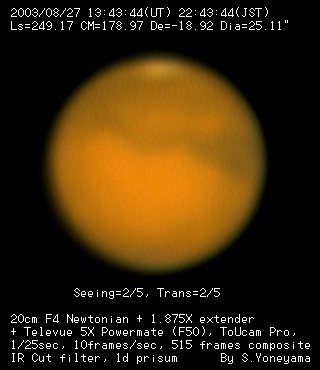
雲に見え隠れする状態の撮影で1分以上
連続での撮影は出来ませんでした。
世紀の大接近当日の記念として撮影しました。
≪神奈川県横浜市 米山誠一≫
|
Mitsuji Morita(203mm Newton, Digital still camera NEC PICONA)
|
|
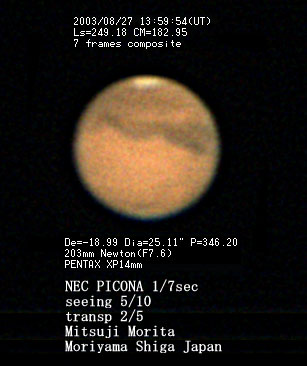
大変状況の悪い中で、ピコナで数カット撮影し処理しました。見てのとおり画質は
大変悪いですが、記念すべき日の画像ですので報告します。ちらちらと見えただけで
もラッキーと言わざるをえません。近所の方も観察にこられました。今(23:56
現在)、望遠鏡はでておりますが、厚い雲が全天を覆っております。
≪滋賀県守山市 森田光治≫
|
Tsuyoshi Arakawa (300mm Newton, ToUcam Pro)
|
|

ほとんど全天を雲が覆うなか、
切れ目をねらって24秒間だ
け撮影できました。
シーイング・透明度ともに悪
く不満足な画像ですが、最接
近の日の画像ということで
報告します。
≪奈良県奈良市 荒川 毅≫
|
Toshihiko Ikemura (310mm Newton, Philips ToUcam PRO)
|
|
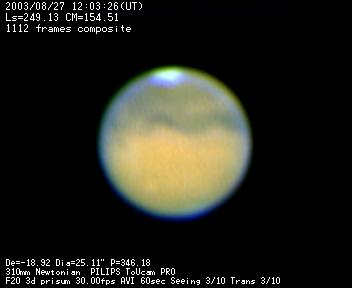
シレーンが明瞭に見えます。
オリンポス山が白い。
雲に覆われているようです。
[T.Ikemura Nagoya Aichi JAPAN]
≪愛知県名古屋市 池村俊彦≫
|
Kenkichi.Yunoki (200mm Newtonian, ToUcam Pro)
|
|

天気予報では曇りであきらめていたが、晴れだしたので慌てて準備、撮像した。この後急速に雲が出てきて撮像はこれだけであった。
最接近の27日にはぜひ撮像したいと考えていたので本当にラッキーでシーイングはともかく本当にうれしい。
なにしろ、視直径25.11"と記せるのはこの日のみで、6万年ぶりの記録更新である。もう一生これを上回る大きさの火星はみられないのだと自分に言い聞かせ、感慨にふけりながら撮像していた。雲が近づきつあったので半分焦りながらではあるが。
タルシス地方、オリンピア山に雲がみられる。
[Kenkichi Yunoki (Sakai City Japan)]
≪大阪府 堺市 柚木健吉≫
|
Kazuyoshi Maeda (350mm Newton, Philips ToUcam Pro)
|
|
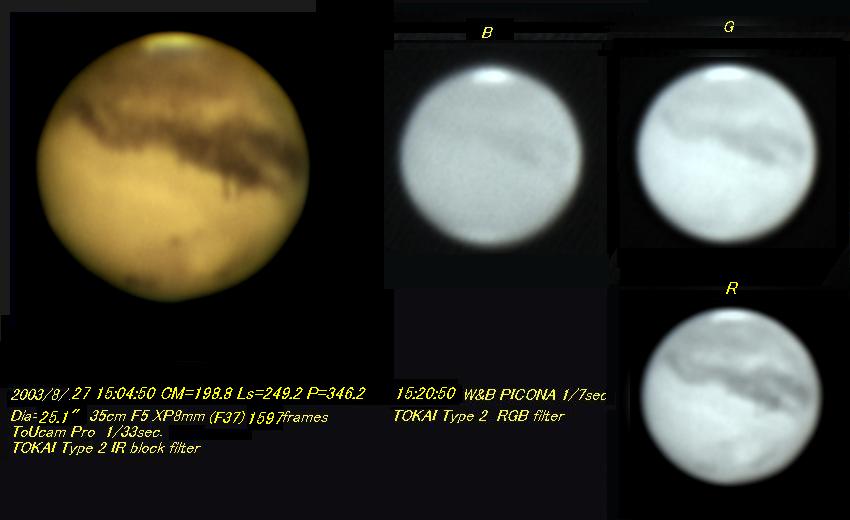
わずかな雲の合い間を待った甲斐あり画像が撮れラッキーでした。
シーイングは4/10,雲越しです。
≪京都府 亀岡市 前田和儀≫
|
Kunihiko Suzuki(190mm Newtonian, Spectra Source Instruments Lynxx2000)
|
|
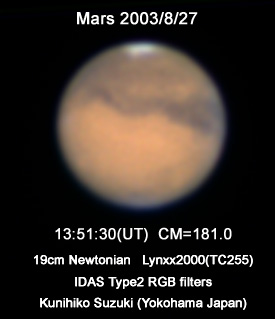
2003/08/27 13:51:30(UT)
CM=181.0
190mm Newtonian, A-16mm
Lynxx2000, R=0.3s G=0.6s B=1.0s
(3*8 frames composite)
Seeing:4/10 Transp:4/5
-----------------------------------------------------------
コメント:
・なんとか再接近の日に20分ほど晴れました。
・左端にオリンピア山が見えています。
[Kunihiko Suzuki : Yokohama-city Kanagawa-Prefecture Japan]
≪神奈川県 横浜市 鈴木邦彦≫
|
Ikuo Takimoto (310mm Newtonian :ToUcam Pro )
|
|
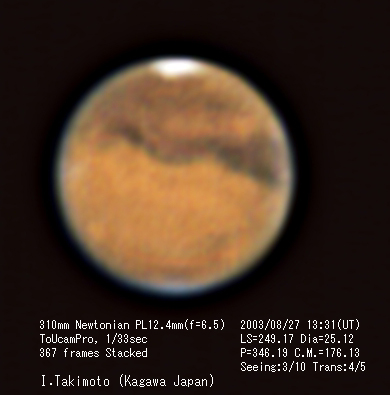
2003/08/27 13:31(UT)
C.M.=176.13
P=346.19
LS=249.17 Dia.=25.12"
310mm Newtonian, PL12.4mm(f=6.5)
ToUcam Pro, 1/33 sec
367 frames Stacked
Seeing:3/10 Trans:4/5
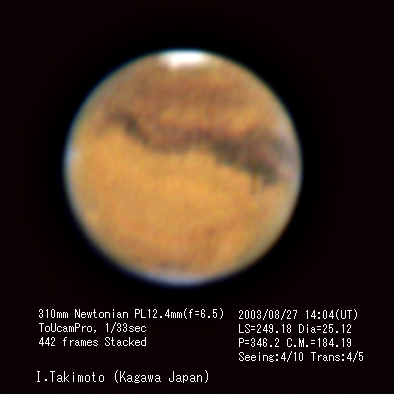
2003/08/27 14:04:00(UT)
C.M.=184.19
P=346.20
LS=249.18 Dia.=25.12"
310mm Newtonian, PL12.4mm(f=6.5)
ToUcam Pro, 1/33 sec
442 frames Stacked
Seeing:4/10 Trans:4/5
-----------------------------------------------------------
コメント:オリンポス山が白く見えている。
なんといっても、今日は世紀の火星大接近!
例の”よだれ”(火星のひげ)が右端に見えてきた。
[Ayauta-gun Kagawa-Prefecture Japan]
≪香川県 綾歌郡 瀧本郁夫≫
|
Hiroaki Akutsu(280mm Newtonian)
|
|
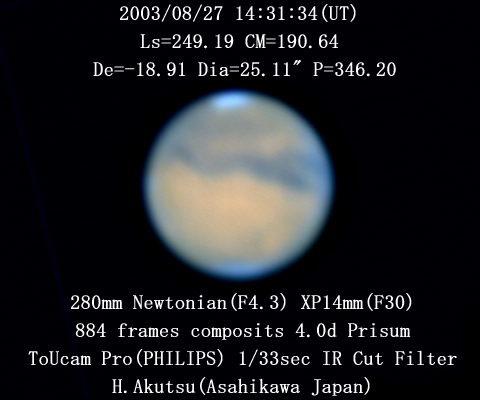
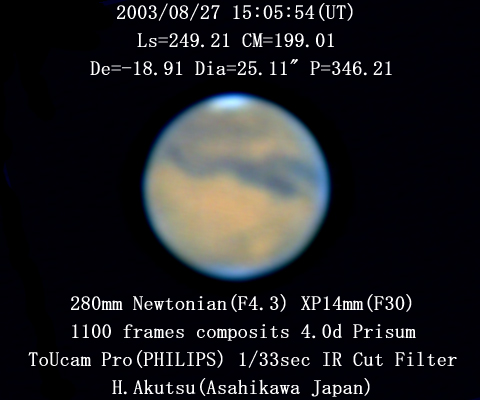
26日の方が大気の状態が落ち着いていました。観望会終了後撮影しました。観望会で疲れました。今日からまた天気が悪くなります。
≪北海道旭川市 阿久津弘明≫
|
Tukasa-Shimizu (350mm Newtonian : Panasonic NV-GS100K)
|
|
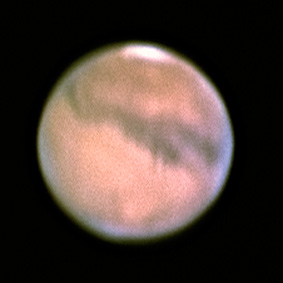
2003/08/27 15:48(UT)
CM=209.28 De=-3 Dia.=25.12"
350mm Newtonian, XP14mm
Panasonic NV-GS100K, 1/60 sec 540 frames Stacked
Seeing:3/10 Trans:3/5運が良ければ最接近の火星の雄姿を見ようと思い観測所に出
かけました。思いがけず、雲の切れ間が来て撮像することができました。
≪岡山県笠岡市 清水司≫
|
Takahiro Kojima (1000mm Cassegrain, ToUcam Pro)
|
|

2003/08/27 13:30:59(UT) 2003/08/27 22:30:59(JST)
CM=176
1000mm F10 Cassgrain + ToUcam Pro 1/250sec 760farmes stacked (IR-Cut filter off) Seeing:3/10
赤外線カットフィルターなし プリズムなし
 2003/08/27 16:02:29(UT) 2003/08/28 01:02:29(JST)
CM=213
1000mm F10 Cassgrain + ToUcam Pro 1/250sec 747farmes stacked (IR-Cut filter off) Seeing:3/10
赤外線カットフィルターなし プリズムなし
--------------------------------------------------------
観望会の合間数分をぬって撮影したため、プリズムまだ使う余裕がありませんでした。フォトショップで強引に大気収差を合わせています。
昨晩の観望会は、午後8時から午前0時半の間に540名の方が火星を覗きました。
アルシア山の上には相変わらず山岳雲がかかっているよう
です。オリンポス山は眼視で確認できませんでした。
≪和歌山県日高郡川辺町かわべ天文公園 小嶋孝弘≫
2003/08/27 16:02:29(UT) 2003/08/28 01:02:29(JST)
CM=213
1000mm F10 Cassgrain + ToUcam Pro 1/250sec 747farmes stacked (IR-Cut filter off) Seeing:3/10
赤外線カットフィルターなし プリズムなし
--------------------------------------------------------
観望会の合間数分をぬって撮影したため、プリズムまだ使う余裕がありませんでした。フォトショップで強引に大気収差を合わせています。
昨晩の観望会は、午後8時から午前0時半の間に540名の方が火星を覗きました。
アルシア山の上には相変わらず山岳雲がかかっているよう
です。オリンポス山は眼視で確認できませんでした。
≪和歌山県日高郡川辺町かわべ天文公園 小嶋孝弘≫
|
hideo Kusakai(200mm newton Philips ToUcam Pro)
|
|
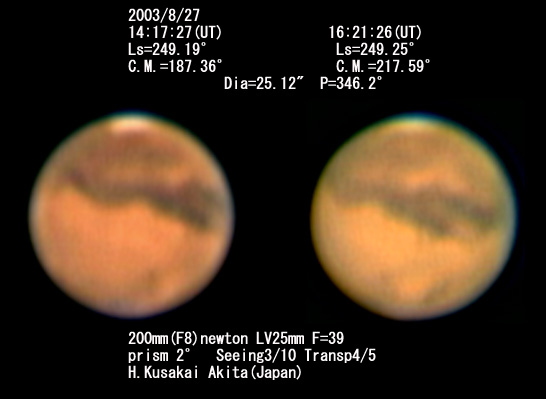
近所の方とデスプレーの映像を見ながらの撮影でした。seeingは全くpoorでしたが、エリュシウムの中が明るく感じました。
[H.Kusakai Akita-city Akita-Pref Japan]
≪秋田県秋田市 草階英夫≫
|
Hirokazu Ohkawa (300mmNewtonian, SONY VX2000)
|
|
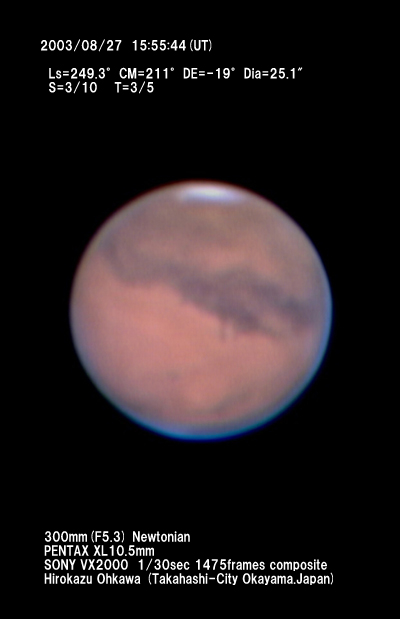
午後11時(JST)ころまでは、
曇天で半ばあきらめの気持ちでしたが、
寝る前にもう一度と思って外へ出たとき、
一瞬でしたが雲の晴間から星が見えたので
もしかして見えるかもしれないと思い、
観測の準備を始めました。
午後11時20分ころに火星が見えたため、
急いで望遠鏡を火星に合わせましたが、
わずか1分ほどでまた雲のなかに…。
その後、約1時間半ほどの間、厚い雲が
次々に通過していきましたが、
突如、午前0時50分ころに晴れ始めたので
撮影を開始。
晴間は当分の間、続きましたが、
次第にシーイングが悪くなっていきましたので、
午前2時すぎに観測を打ち切りました。
[Takahashi-City Okayama-Prefecture Japan]
≪岡山県 高梁市 大河巨和≫
|
Masaru Arai (280mmSMC Newton, Philips ToUcam Pro PCVC740K)
|
|

2003/08/27 12:12:00(UT) CM=157d
280mm SCT ,Extender(f/34)
Philips ToUcam Pro ,1/25 sec
100frames composite
Seeng:2/10 Transp.:0-1/10
IRcut OFF
大接近2時間20分後の火星の姿です。
本画像は、モニタの画面上で火星の円
盤像がやっと確認できるレベルのAVI
ファイルからSTACK処理しました。
[Masaru Arai Yorii-machi Saitama-Prefecture Japan]
≪埼玉県寄居町 新井 優≫
|
Akitoshi Hatanaka (400mm Cassegrain, ToUcam Pro)
|
|
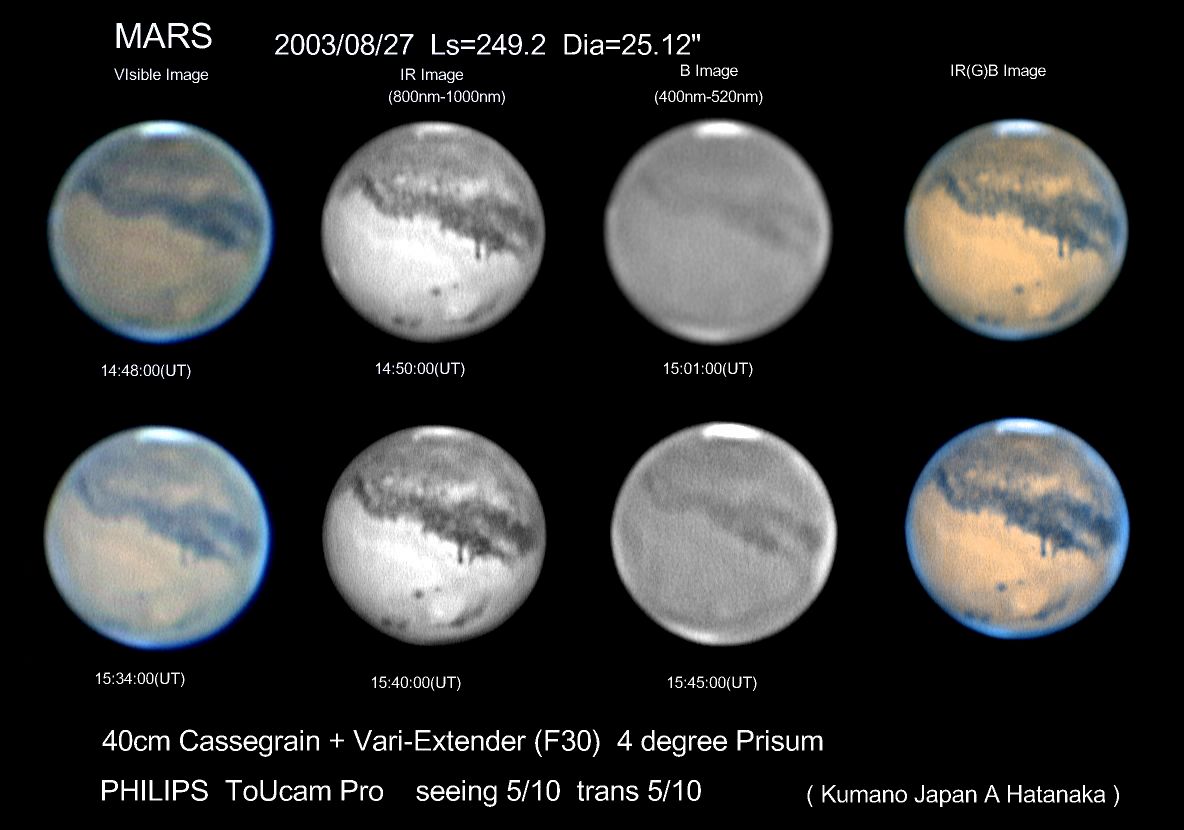
no1 2003/08/27 14:48:00(UT) CM=194.1d 548 Video Frames Composite exposure = 1/50sec 15 fps Sbig IR brocker Filter kenko skylight Filter
no2 2003/08/27 14:56:00(UT) CM=196.3d 1224 Video Frames Composite exposure = 1/25sec FUJI IR80 filter
no3 2003/08/27 15:01:00(UT) CM=197.5d 1268 vide flames composite exposure = 1/25 sec Sbig IR brcker filter kenko Skylight Filter Sbig B Filter
no4 no2 & no3 RGB Composite
no5 2003/08/27 15:35:00(UT) CM=205.8d 1419 Video Frames Composite exposure = 1/50sec 15 fps Sbig IR brocker Filter kenko skylight Filter
no6 2003/08/27 15:40:00(UT) CM=207d 1646 Video Frames Composite exposure = 1/25sec FUJI IR80 filter
no7 2003/08/27 15:45:00(UT) CM=208.3d 1034 vide flames composite exposure = 1/25 sec Sbig IR brocker filter kenko Skylight Filter Sbig B Filter
no8 no6 & no7 RGB Composite
40cm Cassegrain+Vari-Extender(F30) 4 degree Prisum Philips ToUcam Pro Rezistax seeing 5/10 trans 5/10
elysium mons & olympus mons is bright.
エリシウム山やオリンポス山が明るく見えている。
極冠から小さなメダカの卵のような固まりが、分離している。 東西の縁には、朝霧や夕霧のような白い雲が見える。
北極の白くなっている。 最接近の日 奇跡的に晴れ、おまけにseeingも良かった。 観望会を終わって、帰宅して撮影した。
≪三重県熊野市 畑中明利≫
|
Subaru(8200mm Ultra-High-sensitivity HDTV I.I Color Camera(NHK)))
|
|
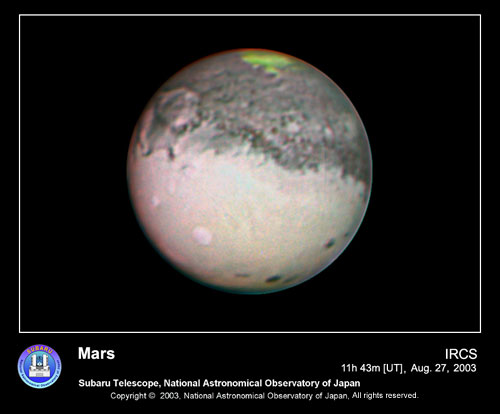
大きなサイズはこちらLarge image
画像は望遠鏡で火星を見たときと同じになるよう、向かって上が南極、下が北極にしてあります。
近赤外線カメラ IRCS によるこの画像は、太陽から出た近赤外線が火星表面で反射した様子を写し出しています。
緑色 (1.7μm;1μmは 0.001mm) は、氷が太陽光を強く反射している地域です。
青色(1.57μm) と 赤色 (2.2μm) は、どちらも岩石の反射を見ています。
可視光に比べ、岩石の部分がより暗く、コントラストがついています。
南極冠:画像向かって上の緑に見えるところが南極冠です。青色と赤色の光は水によって吸収されてしまい、
また緑色の光は太陽光が氷によって反射されている様子を表すため、最終的に南極冠は緑色に見えています。
オリンポス山:画像向かって左下には、太陽系内で最大のオリンポス山が写っています。高さは約25キロメートルと、
富士山のおよそ7倍です。
この画像の火星表面における分解能は約60キロメートル (見た目の角度は約0.24秒角、1秒角は3600分の1度)です。
これはこれまでに得られた火星の近赤外線画像としては、最高の精度といえます。
国立天文台 提供
[ Subaru:Mauna Kea - Hawaii]
|
Donald C Parker((25cm) Mewlon (41cm) Newtonian)
|
|
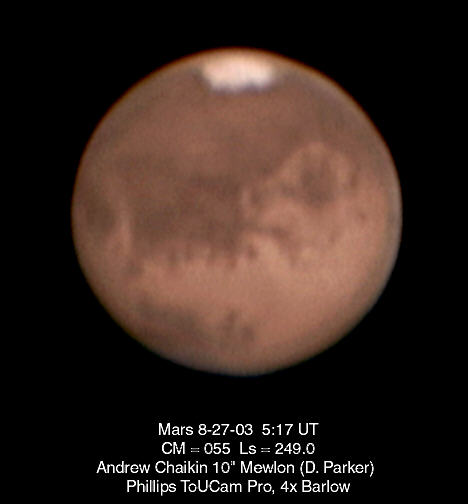 I have attached a Mars images taken by Andy Chaikin with my 10-inch Mewlon
here in beautiful South Florida.
I have attached a Mars images taken by Andy Chaikin with my 10-inch Mewlon
here in beautiful South Florida.
 D.C. Parker, Coral Gables, FL. 16-in (41cm) Newtonian
ToUCam Pro WebCam, Eyepiece Projection @ f/58.6
Integration Times: 1/25 sec, 10 fps x 2 mins.
Processed in K3CCD Tools, 53 images stacked
Images dark corrected.
Seeing fair (6 Pickering). Transparency4-4.5 m with frequent clouds.
High winds NE-E 10-22 kts. Altitude =45 degrees. No dew.
Novus Mons east of SPC. NP Hood conspicuous. Delicate
Am limb clouds over Tharsis, extending into Thaumasia.
AM cloud over Dia.
[ Donald C Parker Coral Gables, Florida U.S.A]
D.C. Parker, Coral Gables, FL. 16-in (41cm) Newtonian
ToUCam Pro WebCam, Eyepiece Projection @ f/58.6
Integration Times: 1/25 sec, 10 fps x 2 mins.
Processed in K3CCD Tools, 53 images stacked
Images dark corrected.
Seeing fair (6 Pickering). Transparency4-4.5 m with frequent clouds.
High winds NE-E 10-22 kts. Altitude =45 degrees. No dew.
Novus Mons east of SPC. NP Hood conspicuous. Delicate
Am limb clouds over Tharsis, extending into Thaumasia.
AM cloud over Dia.
[ Donald C Parker Coral Gables, Florida U.S.A]
|
Dr. P. Clay Sherrod (410mm SC : ToUcam PRO)
|
|
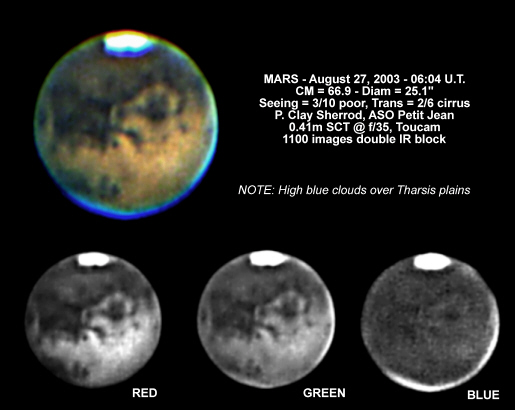
Mars at its closest approach, diameter 25.1" arc; Magnitude -2.9 (!). Seeing conditions very poor with turbulent air and high intermittent cirrus clouds; heavy air with mosquitoes (actually heavy mosquitoes with a bit of air mixed in.....). Note the very faint high blue clouds continuing over the Tharsis region (see ASO images from previous morning). The very bright spot ("flare" of 8-26) is not seen in brilliance in this image, but the southern perimeter of Solis Lacus is turned eastward from direct view at this time; whatever the bright scintillating feature might be, it requires direct sunlight for maximum reflectance and visibility at this time.
[Dr. P. Clay Sherrod Arkansas State U.S.A]
|
Paolo R. Lazzarotti (178mm f/15 Maksutov-Cassegrain Astromeccanica KC381 video CCD camera)
|
|
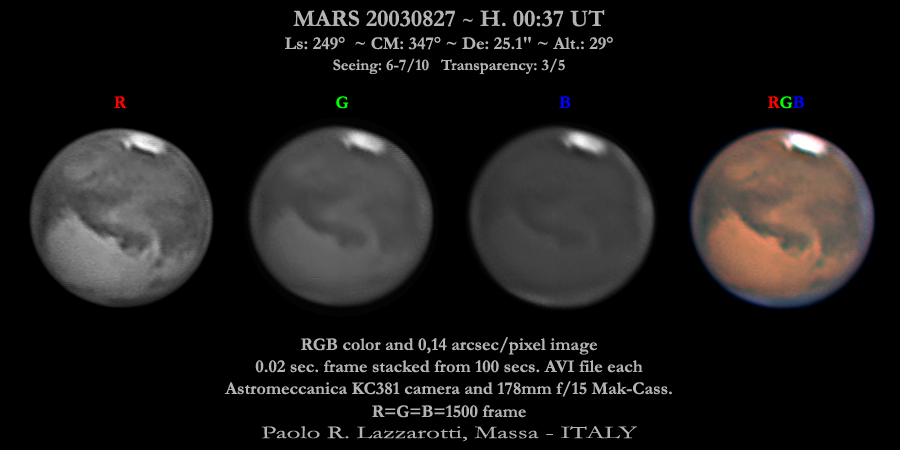 good seeing and fair transparency
[Paolo R. Lazzarotti : Massa-City,Italy]
good seeing and fair transparency
[Paolo R. Lazzarotti : Massa-City,Italy]
|
Ed Grafton (14 inch f/11 Celestron SCT, ST6 CCD medium resolution mode)
|
|
Hi Mars Observers
Here is an monochrome image from August 27th 2003 at 06:51 UT. The sky
transparancy was poor 2/10 and the seeing was good 7/10.
C14 @ f/34.5, ST5 CCD
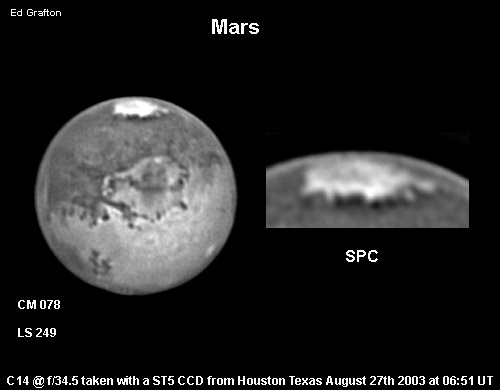 Luminance, IR + Red , 600-1000nm .07 seconds, Edmunds filter
[Ed Grafton, Houston Texas U.S.A.]
Luminance, IR + Red , 600-1000nm .07 seconds, Edmunds filter
[Ed Grafton, Houston Texas U.S.A.]
|
Christophe Pellier (180mm Newtonian webcam Toucam Pro)
|
|
 Hi everyone, the seeing last night was again very variable and in one hour
of time passed from very poor to good ! Unfortunately there was also a haze
that has considerably lowered the contrast of the images.
[Christophe Pellier Bruz City , France]
Hi everyone, the seeing last night was again very variable and in one hour
of time passed from very poor to good ! Unfortunately there was also a haze
that has considerably lowered the contrast of the images.
[Christophe Pellier Bruz City , France]
|
Paulo Casquinha ( 200mm f/5 Newton Reflector Toucam Pro)
|
|
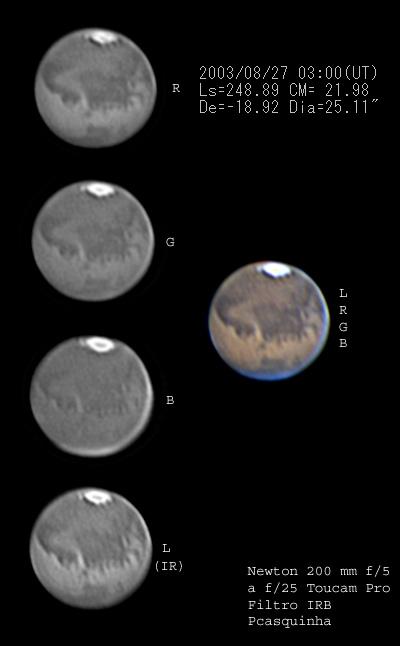 (site: 38.567 N /8.933 W Alt 124 m)
[Paulo Casquinha Palmela, Portugal]
(site: 38.567 N /8.933 W Alt 124 m)
[Paulo Casquinha Palmela, Portugal]
|
Tsai Yuan Sheng (C14 NJP: ToUcam)
|
|
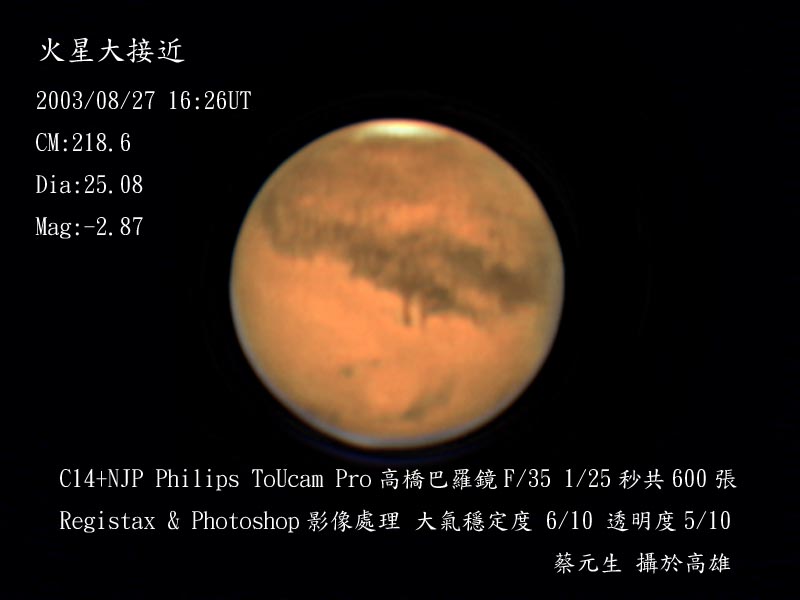
 [Tsai Yuan Sheng, Kaohsiung, Taiwan]
[Tsai Yuan Sheng, Kaohsiung, Taiwan]
|
Eric Ng (12.5" D317mm F6 Royce Newtonian : ToUcam Pro)
|
|
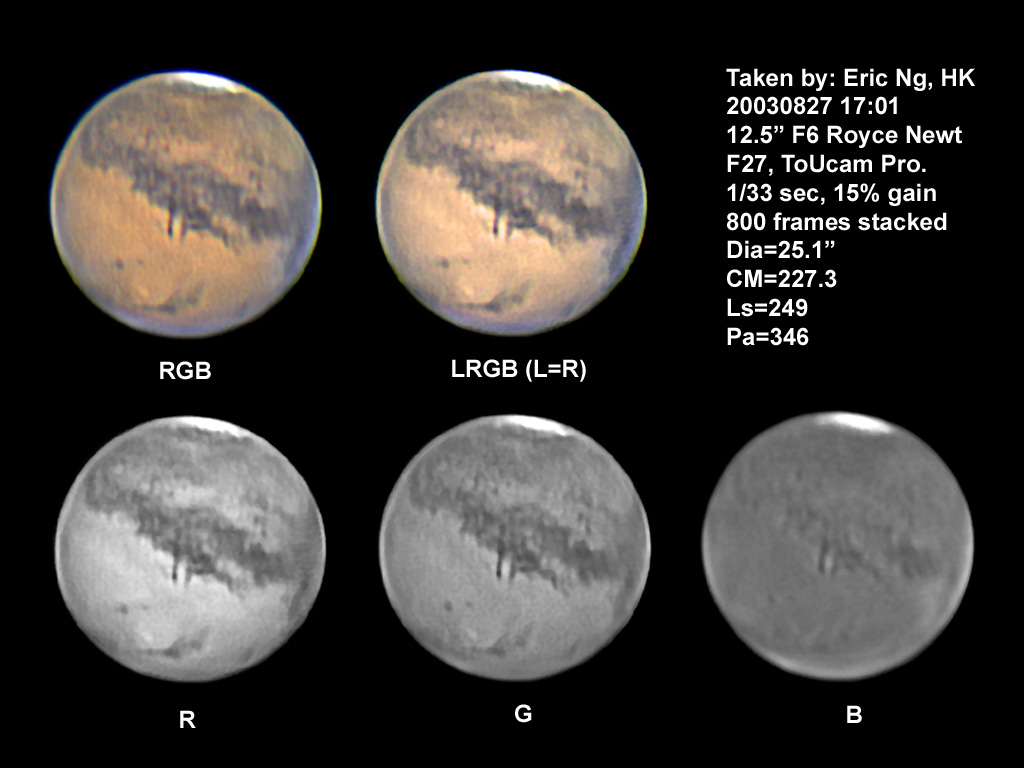
Dear friends,
This is my first mars image after I returned from US (Actually my last mars image was taken on 18 July). Fortunately the sky turned to be clear when Mars at closest last night. Seeing and transparency were 6/10. The coming few days will be clear too and I wish I can capture more shots.
Kind Regards
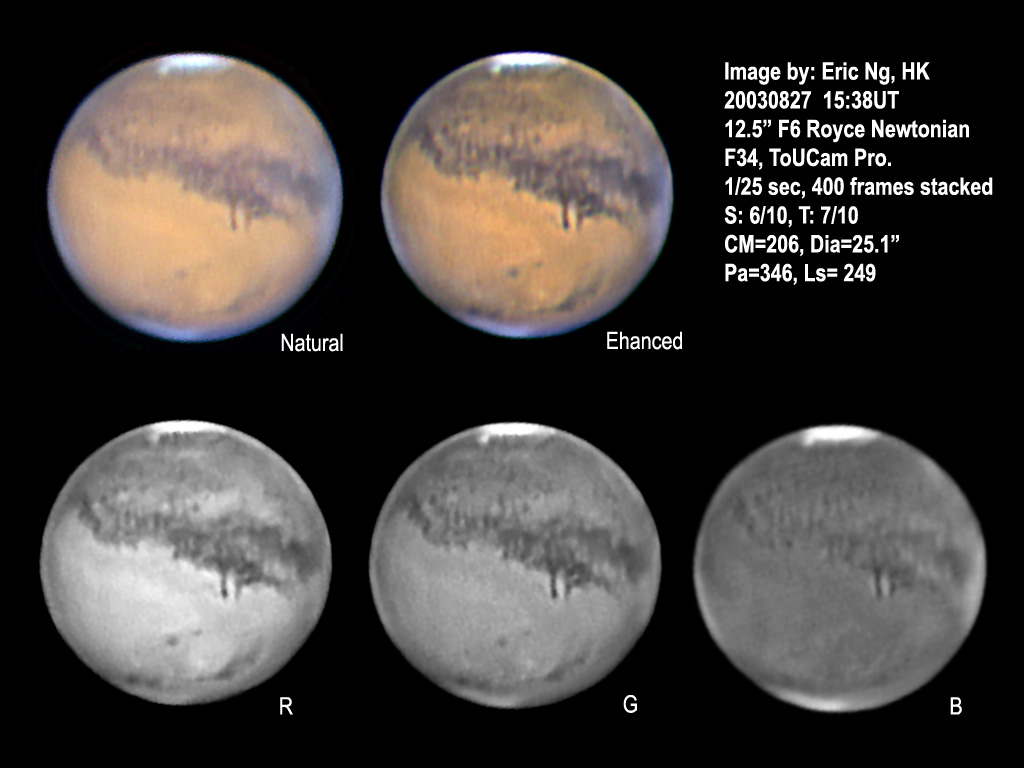
Dear friends,
While a very strong typhoon is approaching HK directly. I am processing another 20030827 mars processed from one of the best AVI. I put
two processed version, one is more natural processed and the other one is enhanced. Thanks for the suggestion from Weileong
[Eric Ng, Tai Po site Hong Kong, China]
|
Ferruccio Zanotti ( Newtonian 450 closed ad 150 or 170 mm : webcam Philips ToUcam pro)
|
|
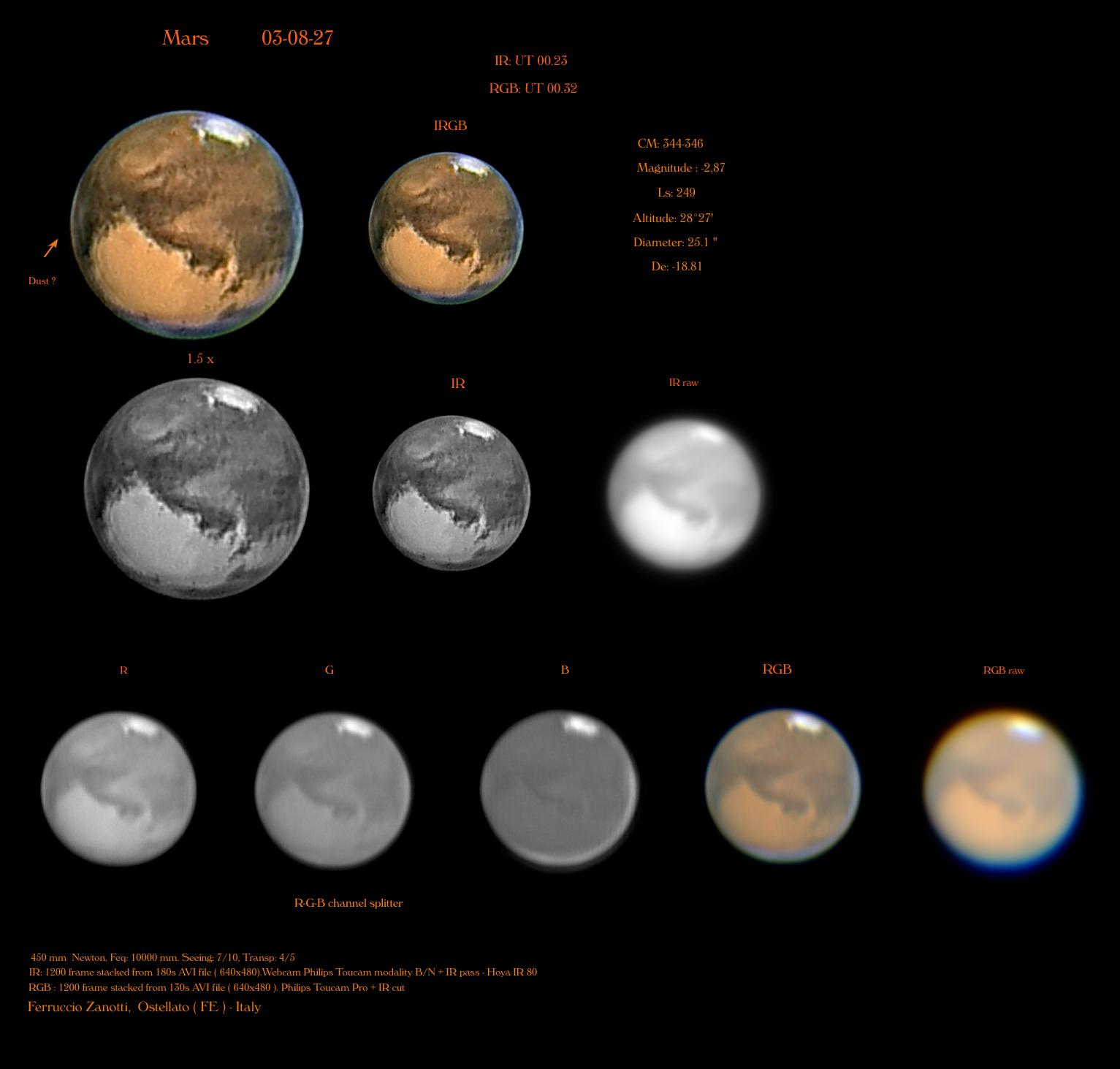
Hi at all,
Over the Syrtismajor there is a little dust storm?
Best Regards
[Ferruccio Zanotti , Ferrara-Italy]
|
Nicolas Biver (256mm Newtonian Drawing)
|
|
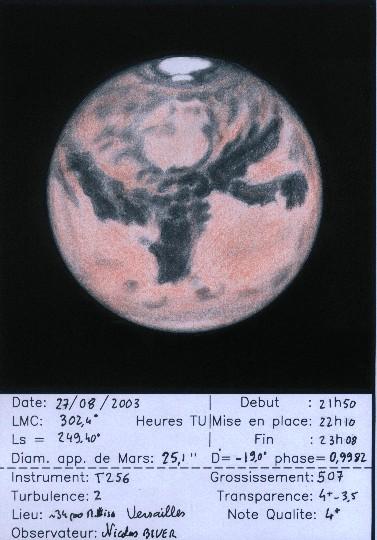
2003-08-27 22:10 UT
CML=302.4 Dia.=25.1" Ls=249.40
Seeing 6/10 (fair-good) Transparency 7-8/10
25.6-cm Newtonian x507
Versailles (France)
[Nicolas Biver MEUDON, FRANCE]
|
Tan Wei Leong(250mm Dall Kirkham ; Philips ToUcam Pro PCVC740K camera)
|
 Dear friends
Attached is the mars image from 27th August 2003.
We had a session for a school here in Singapore which we setup some
telescopes for the students. Many of them had their first few of mars thru
the scopes. I am sure that all of them went away with great memories of this
closest encounter.
By the time we pack up and went to the observatory the seeing has degraded
and clouds already started to rolled in. I managed to capture just one AVI
for the whole night. Seeing was very bad and I could not all.
I managed to picked out 23 frames out of 2400 frames from this AVI and
processed this image. Transparency is bad as a thin layer of clouds already
rolled in.
Anyway we still get one image :)
Thanks for looking
[Tan Wei Leong Singapore]
Dear friends
Attached is the mars image from 27th August 2003.
We had a session for a school here in Singapore which we setup some
telescopes for the students. Many of them had their first few of mars thru
the scopes. I am sure that all of them went away with great memories of this
closest encounter.
By the time we pack up and went to the observatory the seeing has degraded
and clouds already started to rolled in. I managed to capture just one AVI
for the whole night. Seeing was very bad and I could not all.
I managed to picked out 23 frames out of 2400 frames from this AVI and
processed this image. Transparency is bad as a thin layer of clouds already
rolled in.
Anyway we still get one image :)
Thanks for looking
[Tan Wei Leong Singapore]
|
Domenico Licchelli (MAK-CASS 127mm F12 ToUcamPRO)
|
|
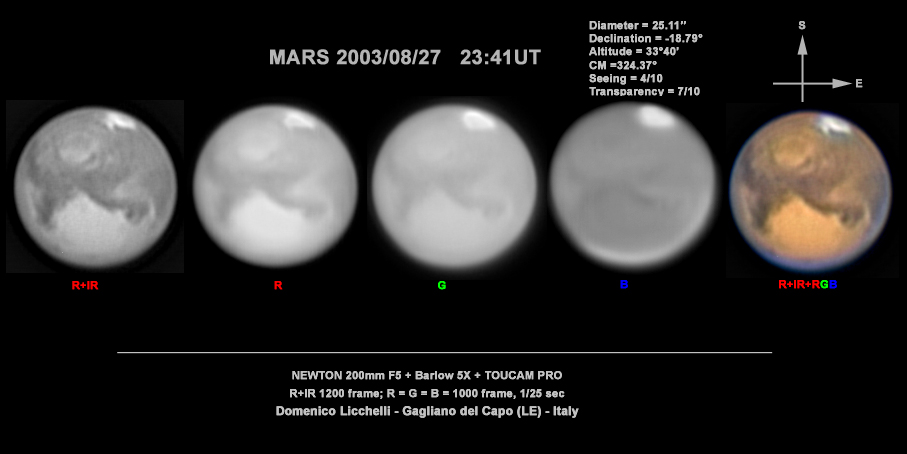 [Domenico Licchelli ,Gagliano del Capo, Italy]
[Domenico Licchelli ,Gagliano del Capo, Italy]
|
Daniel Crussaire (refractor fluorite 102mm Philips Vesta Pro )
|
|

I attached one of my last images taken just one hour before Mars closest
approach from Paris (topocentric coordinates), August, 27th at 1h20 UT with
0,372711 astronomical units (soft processing). Looking for the image taken at 1h20
UT (1800 frames) may be a little better but not yet processed. Weather always
cloudy this night...
[Daniel Crussaire Paris-Meudon, France]
|
Brian Colville(300mm F10 Schmidt-Cass:ToUcam Pro)
|
|
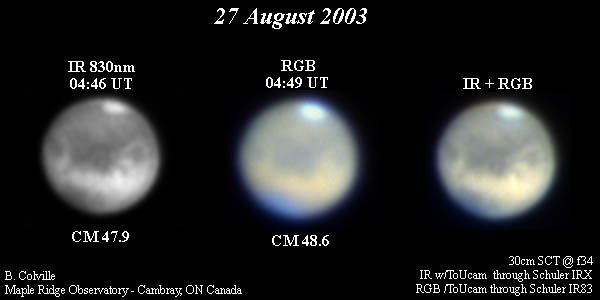
taken with the 30cm SCT @f34 (standard Maple Ridge scope) and ToUcam with Schuler filters.
Seeing was poor both nights, and I manually selected the best 10-12 fames from 450 in the video clip.
[ Brian Colville : Cambray Canada]
|
Hubble Space Telescope(2900mm fl=5300mm)
|
South up South up  Original image tif 800X800 1885kb Original image tif 800X800 1885kb
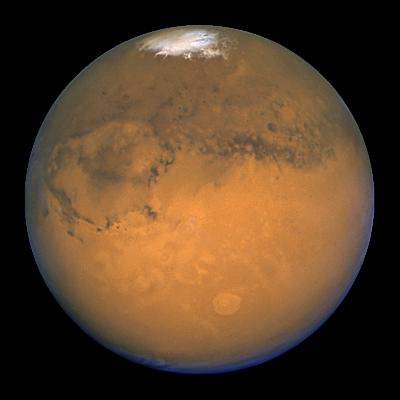
NASA's Hubble Space Telescope snapped this portrait of Mars within minutes of the planet's closest approach to Earth in nearly 60,000 years. This image was made from a series of exposures taken between 5:35 a.m. and 6:20 a.m. EDT Aug. 27 with Hubble's Wide Field and Planetary Camera 2. In this picture, the red planet is 34,647,420 miles (55,757,930 km) from Earth.
This sharp, natural-color view of Mars reveals several prominent Martian features, including the largest volcano in the solar system, Olympus Mons; a system of canyons called Valles Marineris; an immense dark marking called Solis Lacus; and the southern polar ice cap.
Olympus Mons [the oval-shaped feature just above center] is the size of Arizona and three times higher than Mount Everest. The dormant volcano resides in a region called the Tharsis Bulge, which is about the size of the U.S. and home to several extinct volcanoes. The three Tharsis Montes volcanoes are lined up just below Olympus Mons. Faint clouds are hovering over Arsia Mons, the southernmost of these volcanoes.
The long, dark scar, below and to the right of the Tharsis Bulge, is Valles Marineris, a 2,480-mile (4,000-km) system of canyons. Just below Valles Marineris is Solis Lacus, also known as the "Eye of Mars." The dark features to the left of Solis Lacus are the southern highlands, called Terra Sirenum, a region riddled with impact craters. The diameters of these craters range from 31 to 124 miles (50 to 200 km).
The image was taken during the middle of summer in the Southern Hemisphere. During this season the Sun shines continuously on the southern polar ice cap, causing the cap to shrink in size [bottom of image]. The orange streaks are indications of dust activity over the polar cap. The cap is made of carbon dioxide ice and water ice, but only carbon dioxide ice is seen in this image. The water ice is buried beneath the carbon dioxide ice. It will only be revealed when the cap recedes even more over the next two months. By contrast, the Northern Hemisphere is in the midst of winter. A wave of clouds covers the northern polar ice cap and the surrounding region [top of image].
This view of Mars reveals a striking contrast between the Northern and Southern hemispheres. The Northern Hemisphere is home to volcanoes that may have been active about 1 billion years ago. These volcanoes resurfaced the north's landscape, perhaps filling in many impact craters. The Southern Hemisphere is pockmarked with ancient impact craters, which appear dark because many are filled with coarser sand-sized particles.
Mars and Earth make a "close encounter" about every 26 months. These periodic encounters are due to the differences in the two planets' orbits. Earth goes around the Sun twice as fast as Mars, lapping the red planet about every two years. Both planets have elliptical orbits, so their close encounters are not always at the same distance. In its close encounter with Earth in 2001, for example, Mars was about 9 million miles farther away. Because Mars was much closer during this year's rendezvous, the planet will appeared 23 percent larger in the sky. Mars will not be this close again until 2287.
This photograph is a color composite generated from observations taken with blue, green, and red filters. A total of 11 filters, spanning a wide wavelength range?-from blue to near infrared?-were used during the observations. The shorter wavelengths show clouds and other atmospheric changes. The longer wavelengths, including the near infrared, reveal Martian surface features.
Credit: NASA, J. Bell (Cornell U.) and M. Wolff (SSI)
[NASA/JPL/Space Science Institute]
 ALPO-Japan Latest ALPO-Japan Latest

 Mars Section Mars Section
|
 2003/08/27 16:02:29(UT) 2003/08/28 01:02:29(JST)
CM=213
1000mm F10 Cassgrain + ToUcam Pro 1/250sec 747farmes stacked (IR-Cut filter off) Seeing:3/10
赤外線カットフィルターなし プリズムなし
--------------------------------------------------------
観望会の合間数分をぬって撮影したため、プリズムまだ使う余裕がありませんでした。フォトショップで強引に大気収差を合わせています。
昨晩の観望会は、午後8時から午前0時半の間に540名の方が火星を覗きました。
アルシア山の上には相変わらず山岳雲がかかっているよう
です。オリンポス山は眼視で確認できませんでした。
≪和歌山県日高郡川辺町かわべ天文公園 小嶋孝弘≫
2003/08/27 16:02:29(UT) 2003/08/28 01:02:29(JST)
CM=213
1000mm F10 Cassgrain + ToUcam Pro 1/250sec 747farmes stacked (IR-Cut filter off) Seeing:3/10
赤外線カットフィルターなし プリズムなし
--------------------------------------------------------
観望会の合間数分をぬって撮影したため、プリズムまだ使う余裕がありませんでした。フォトショップで強引に大気収差を合わせています。
昨晩の観望会は、午後8時から午前0時半の間に540名の方が火星を覗きました。
アルシア山の上には相変わらず山岳雲がかかっているよう
です。オリンポス山は眼視で確認できませんでした。
≪和歌山県日高郡川辺町かわべ天文公園 小嶋孝弘≫

















 I have attached a Mars images taken by Andy Chaikin with my 10-inch Mewlon
here in beautiful South Florida.
I have attached a Mars images taken by Andy Chaikin with my 10-inch Mewlon
here in beautiful South Florida.
 D.C. Parker, Coral Gables, FL. 16-in (41cm) Newtonian
ToUCam Pro WebCam, Eyepiece Projection @ f/58.6
Integration Times: 1/25 sec, 10 fps x 2 mins.
Processed in K3CCD Tools, 53 images stacked
Images dark corrected.
Seeing fair (6 Pickering). Transparency4-4.5 m with frequent clouds.
High winds NE-E 10-22 kts. Altitude =45 degrees. No dew.
Novus Mons east of SPC. NP Hood conspicuous. Delicate
Am limb clouds over Tharsis, extending into Thaumasia.
AM cloud over Dia.
[ Donald C Parker Coral Gables, Florida U.S.A]
D.C. Parker, Coral Gables, FL. 16-in (41cm) Newtonian
ToUCam Pro WebCam, Eyepiece Projection @ f/58.6
Integration Times: 1/25 sec, 10 fps x 2 mins.
Processed in K3CCD Tools, 53 images stacked
Images dark corrected.
Seeing fair (6 Pickering). Transparency4-4.5 m with frequent clouds.
High winds NE-E 10-22 kts. Altitude =45 degrees. No dew.
Novus Mons east of SPC. NP Hood conspicuous. Delicate
Am limb clouds over Tharsis, extending into Thaumasia.
AM cloud over Dia.
[ Donald C Parker Coral Gables, Florida U.S.A]
 good seeing and fair transparency
[Paolo R. Lazzarotti : Massa-City,Italy]
good seeing and fair transparency
[Paolo R. Lazzarotti : Massa-City,Italy] Luminance, IR + Red , 600-1000nm .07 seconds, Edmunds filter
[Ed Grafton, Houston Texas U.S.A.]
Luminance, IR + Red , 600-1000nm .07 seconds, Edmunds filter
[Ed Grafton, Houston Texas U.S.A.] Hi everyone, the seeing last night was again very variable and in one hour
of time passed from very poor to good ! Unfortunately there was also a haze
that has considerably lowered the contrast of the images.
[Christophe Pellier Bruz City , France]
Hi everyone, the seeing last night was again very variable and in one hour
of time passed from very poor to good ! Unfortunately there was also a haze
that has considerably lowered the contrast of the images.
[Christophe Pellier Bruz City , France] (site: 38.567 N /8.933 W Alt 124 m)
[Paulo Casquinha Palmela, Portugal]
(site: 38.567 N /8.933 W Alt 124 m)
[Paulo Casquinha Palmela, Portugal] 
 [Tsai Yuan Sheng, Kaohsiung, Taiwan]
[Tsai Yuan Sheng, Kaohsiung, Taiwan]



 Dear friends
Attached is the mars image from 27th August 2003.
We had a session for a school here in Singapore which we setup some
telescopes for the students. Many of them had their first few of mars thru
the scopes. I am sure that all of them went away with great memories of this
closest encounter.
By the time we pack up and went to the observatory the seeing has degraded
and clouds already started to rolled in. I managed to capture just one AVI
for the whole night. Seeing was very bad and I could not all.
I managed to picked out 23 frames out of 2400 frames from this AVI and
processed this image. Transparency is bad as a thin layer of clouds already
rolled in.
Anyway we still get one image :)
Thanks for looking
[Tan Wei Leong Singapore]
Dear friends
Attached is the mars image from 27th August 2003.
We had a session for a school here in Singapore which we setup some
telescopes for the students. Many of them had their first few of mars thru
the scopes. I am sure that all of them went away with great memories of this
closest encounter.
By the time we pack up and went to the observatory the seeing has degraded
and clouds already started to rolled in. I managed to capture just one AVI
for the whole night. Seeing was very bad and I could not all.
I managed to picked out 23 frames out of 2400 frames from this AVI and
processed this image. Transparency is bad as a thin layer of clouds already
rolled in.
Anyway we still get one image :)
Thanks for looking
[Tan Wei Leong Singapore] [Domenico Licchelli ,Gagliano del Capo, Italy]
[Domenico Licchelli ,Gagliano del Capo, Italy]

 Original image tif 800X800 1885kb
Original image tif 800X800 1885kb
 ALPO-Japan Latest
ALPO-Japan Latest
